Key in a search term below to search our website.
Key in a search term below to search our website.
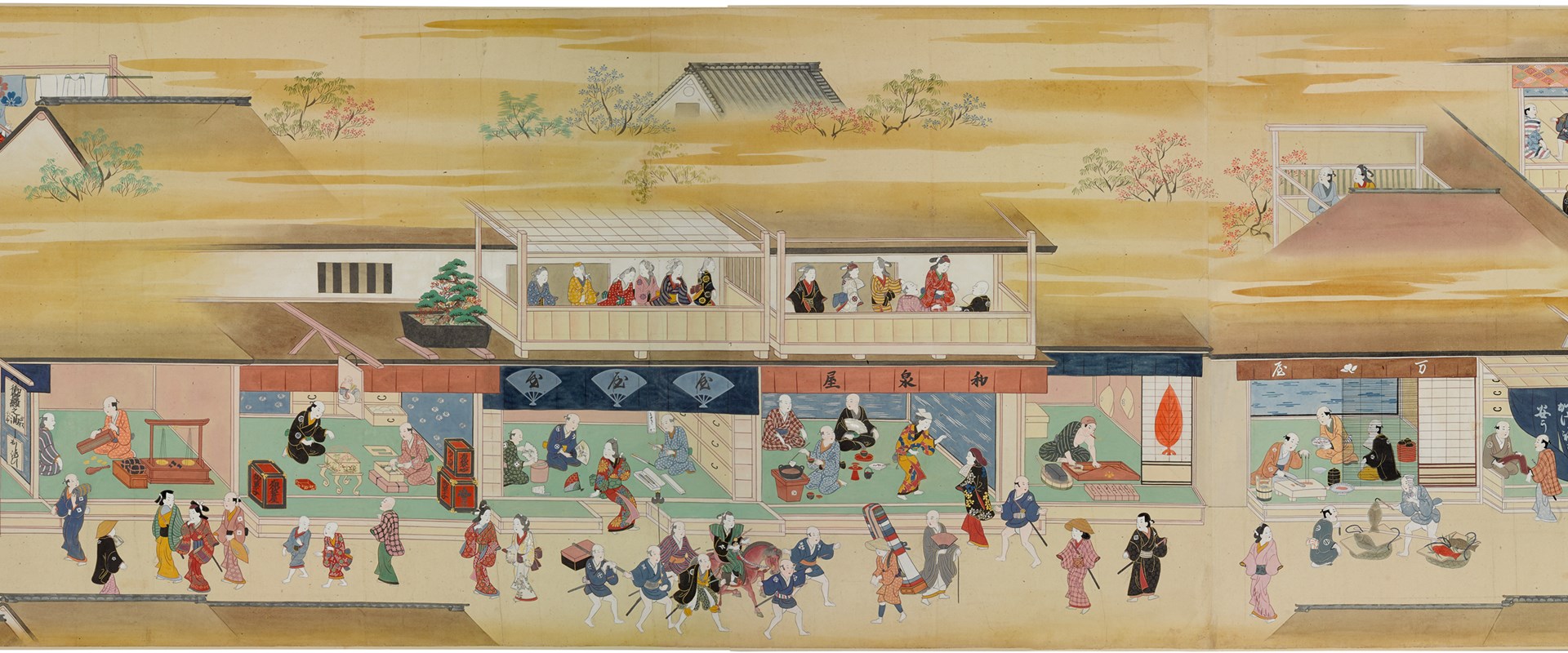
This 13-metre-long handscroll shows the bustling life of the theatre district of Edo (today's Tokyo) around 1700.
Entitled Theatres of the East, the handscroll shows people enjoying a range of entertainment from puppet shows and Kabuki theatre to comic skits and private parties.
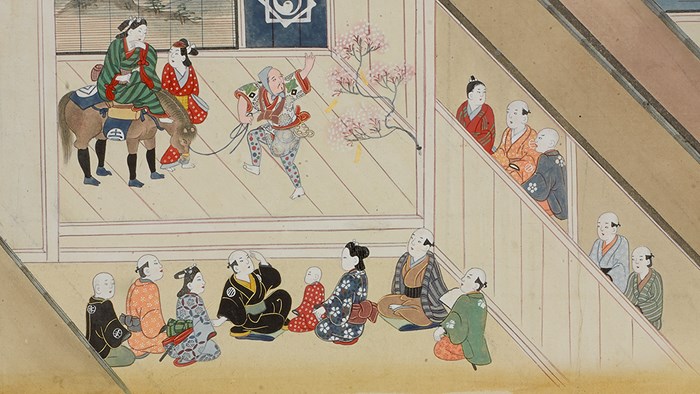
A clown-like figure and an actor on horseback act out a comic scene. You can see that the 'horse' - wearing socks - is played by two actors inside a costume.
Date
1710–30
Made by
Furuyama Moromasa
Made from
Ink, colours, gold and silver on paper
Made in
Japan
Museum reference
IL.2015.59.1
On loan from The City of Edinburgh Council
On display
Exploring East Asia, Level 5, National Museum of Scotland
Did you know?
As this handscroll is 13 metres long, it would have been unrolled one section at a time for close-up viewing. The handscroll will be displayed one section at a time in our gallery, and this will change over time.
The handscroll format is compact and portable, and its continuous surface allows for effective storytelling. Watch this short video to find out more about how this type of painting was appreciated in Japan.
The artist's signature - 'Picture by the Japanese artist Furuyama Moromasa' - and his red seal appear at the end of the handscroll. Furuyama Moromasa (active 1700–1748) was a painter and print designer of imagery depicting the popular entertainments in the city of Edo. He was grandson of the renowned artist Hishikawa Moronobu (1618–94), who had founded this genre.
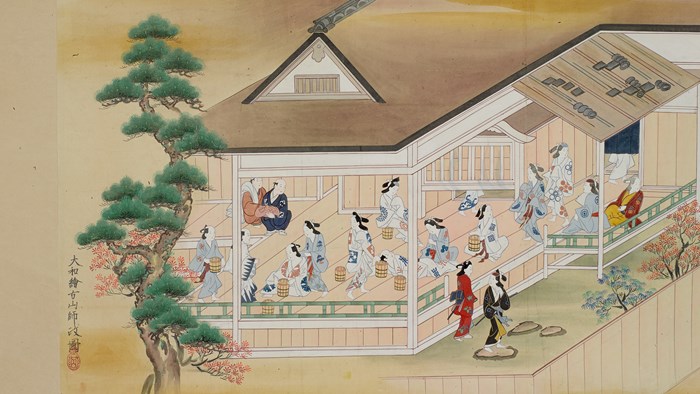
The handscroll is brought to a close by a powerful, twisting pine tree with vivid green needles, followed by the signature and seal of the artist Furuyama Moromasa.
This handscroll was brought to Scotland by Glaswegian engineer Henry Dyer (23 August 1848 – 25 September 1918). Dyer spent many years working within the education system in Japan and during this time acquired a collection of Japanese artworks. The handscroll was gifted to Edinburgh City Libraries in the 1940s by Henry Dyer's daughter.
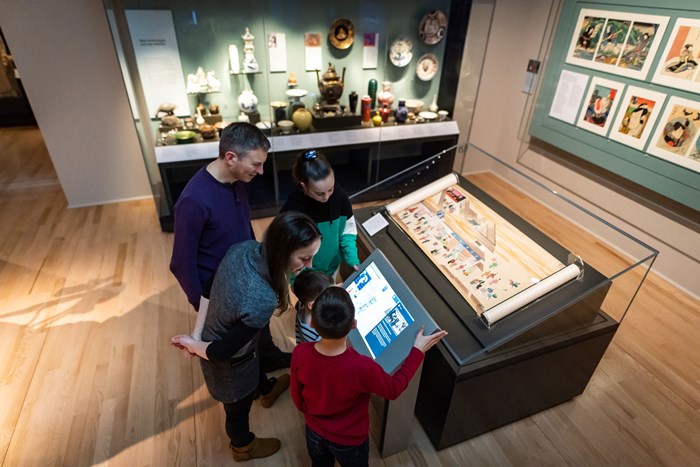
This handscroll on display in our Exploring East Asia gallery. Photo © Andy Catlin.
The handscroll is viewed from right to left, each section provides a fascinating glimpse into shops, theatres, and even a bath-house! Delve into a few of the details below, or visit our Exploring East Asia gallery to explore further.
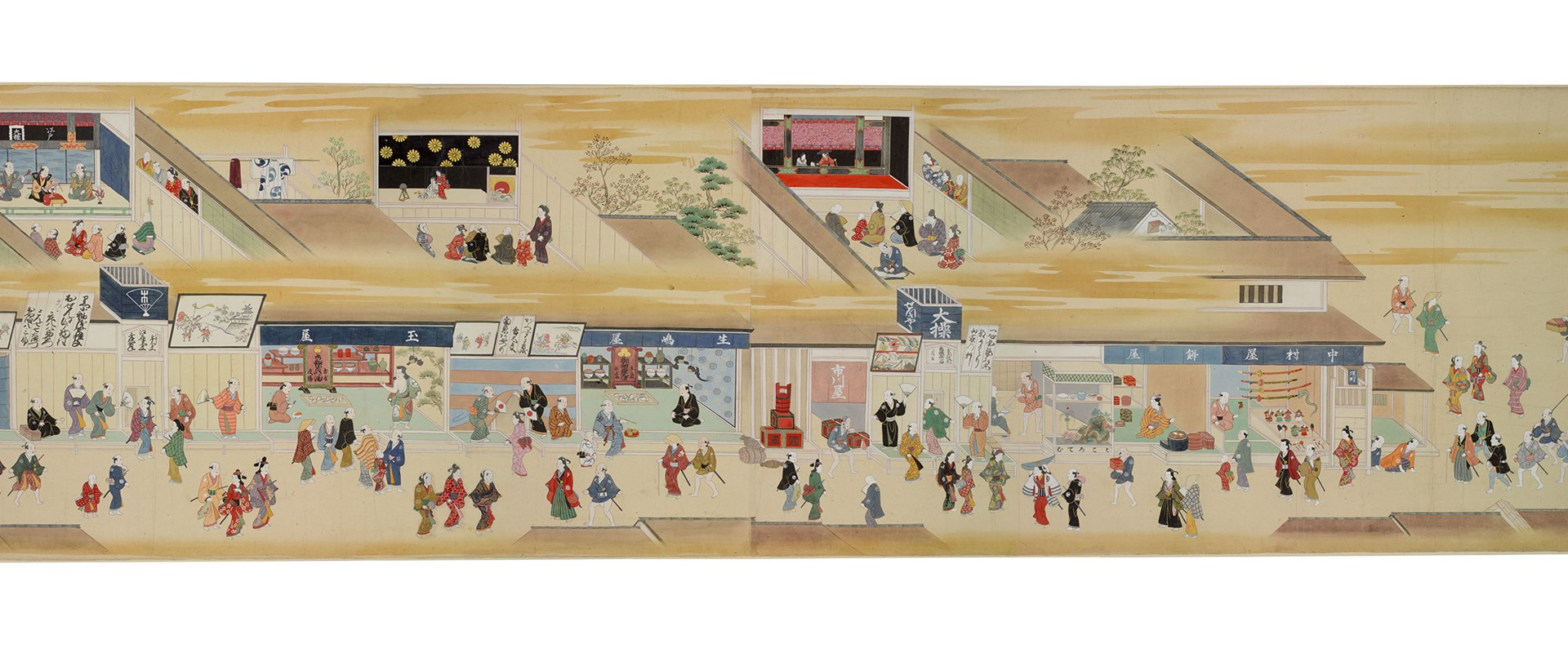
 Greeting a patron
Greeting a patronAt the entrance to the theatre district employees greet a mature samurai leaning on a stick, possibly the patron who commissioned this painting.
The presence of servants indicate his importance, as does his formal clothing, which includes hakama, a divided skirt rather like trousers.
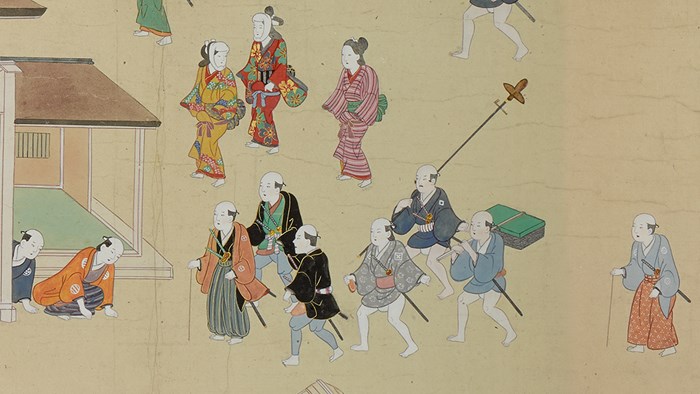
 Puppet theatre
Puppet theatrePuppet theatre, or jōruri, was enjoyed by all ages. The puppets in the scroll are performing a famous hair-shaving scene from a popular drama about the Soga brothers' revenge of their father's murder.
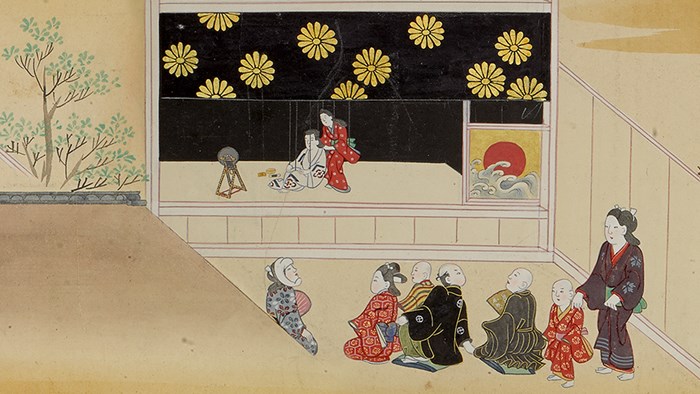
 Barkers outside a theatre
Barkers outside a theatreEven 300 years ago people were bombarded with advertising: outside the theatres, barkers called to passers-by to entice them in, posters listed acts and displayed key scenes from plays, and billboards listed high-profile actors' names.
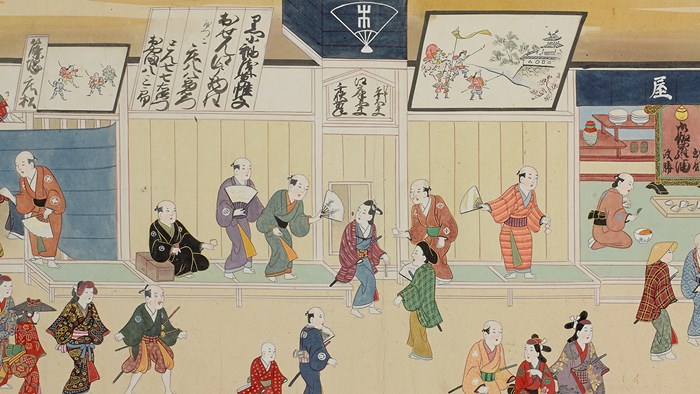
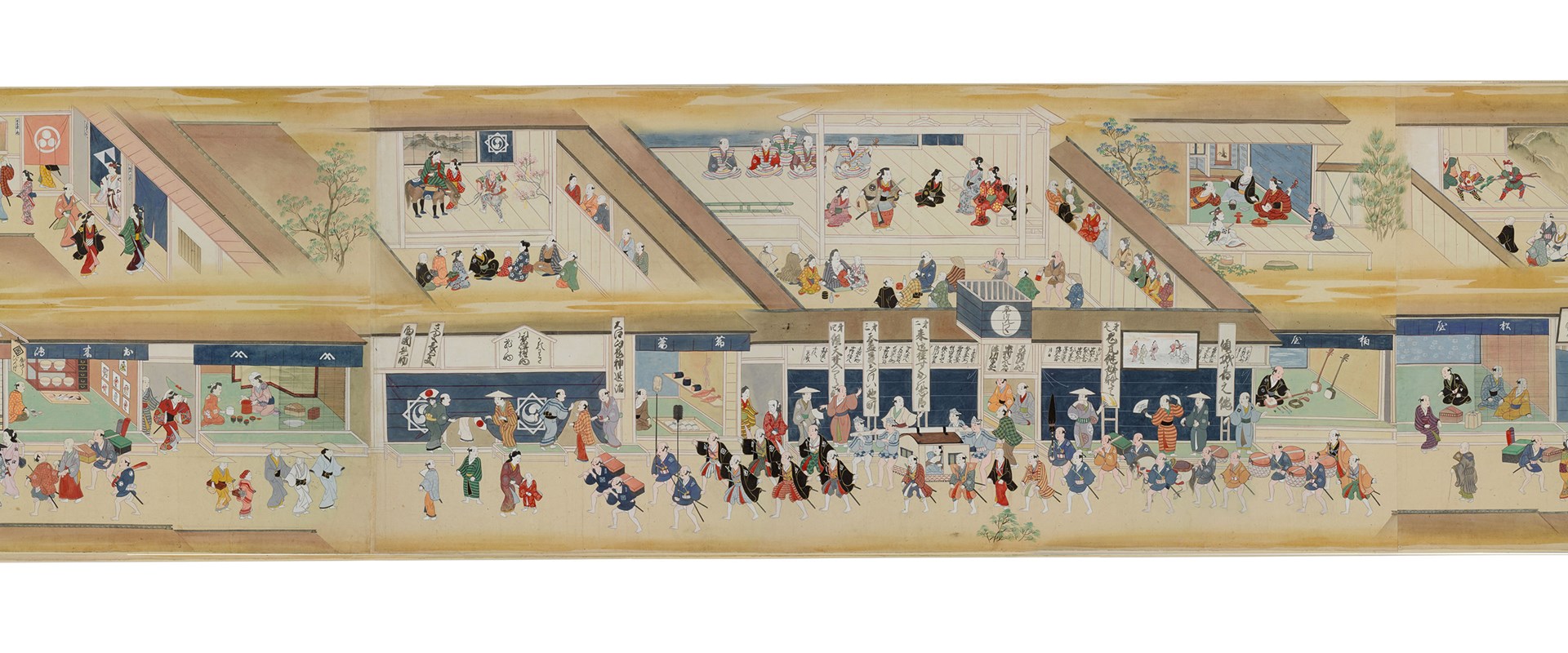
 Private party
Private partyThe shamisen is a three-stringed instrument plucked with a plectrum and is a key element in the music of Kabuki. The figure playing the shamisen is an onnagata, a male actor who specialises in playing women's roles. In the shop below, a shamisen is being assembled by a craftsman.
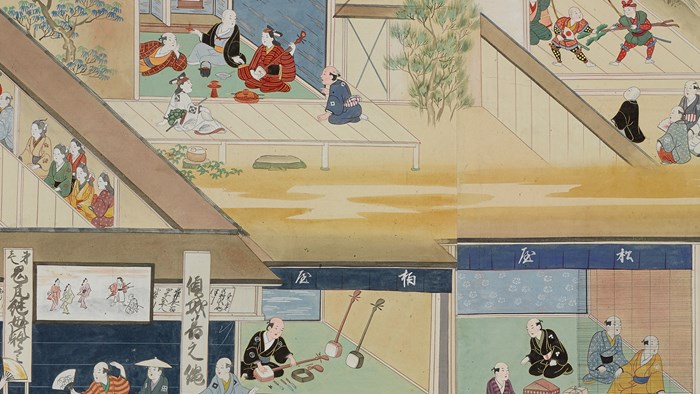
 Nakamura Theatre
Nakamura TheatreThe Nakamura-za was one of four official Kabuki theatres in Edo. Music is a significant part of Kabuki - here, chanters and shamisen players are seated at the back of the stage. The atmosphere is relaxed, with food and drinks being served to the audience, and a mother breast-feeding her child.
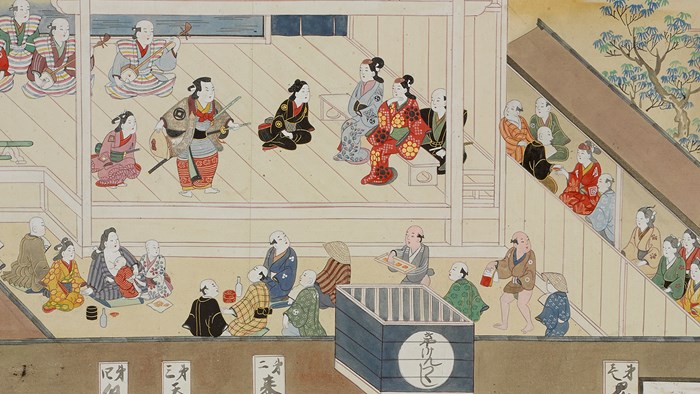
 Samurai procession
Samurai processionHere we can see people turning to watch the procession of a samurai lord. The lord is carried in a palanquin (a covered litter, usually for one passenger) by his retainers. Samurai are recognisable as only they were allowed to wear two swords, a sign of their status at the top of the social hierarchy.
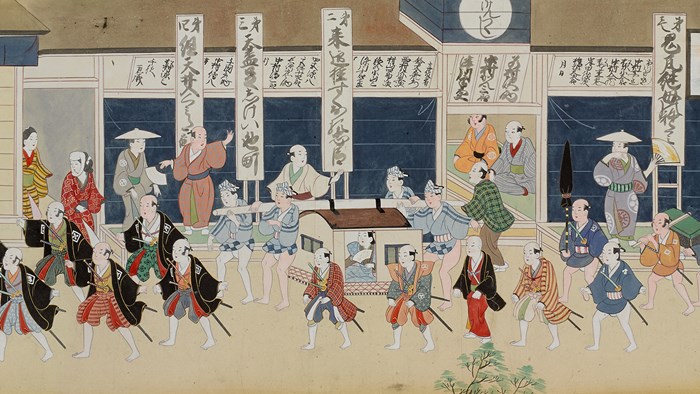
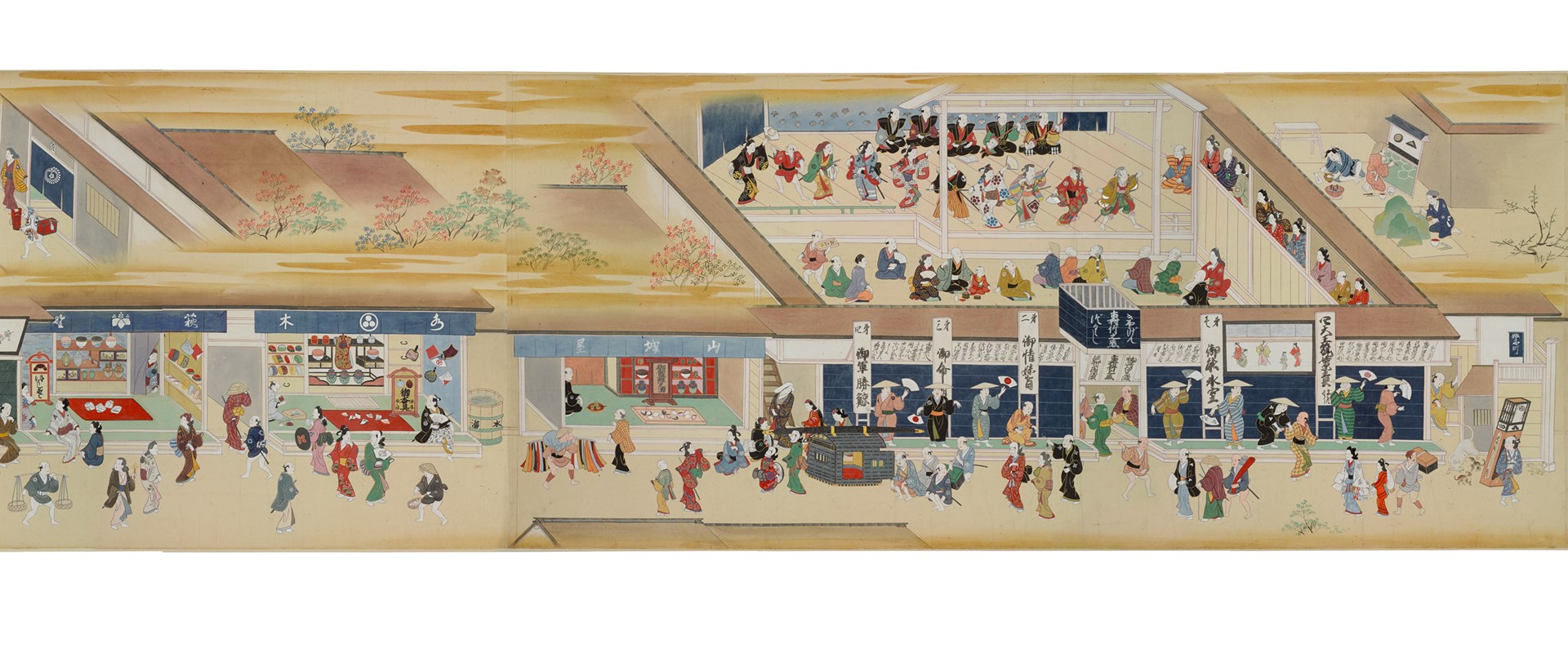
 Painting stage props
Painting stage propsStage props and scenery are being painted next to the Ichimura theatre, one of four official Kabuki theatres in Edo. These atmospheric backdrops were used to help bring the popular Kabuki dramas and romances to life.
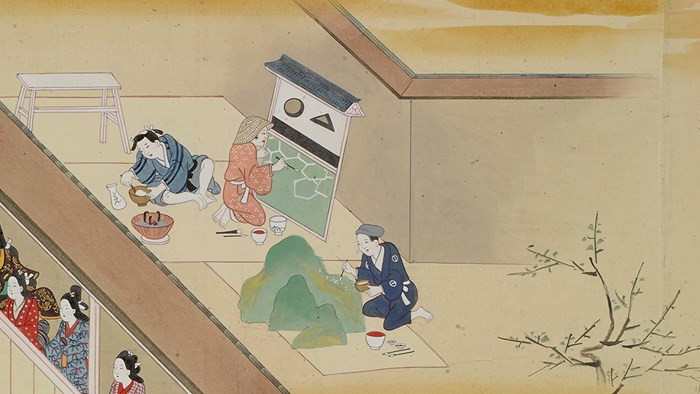
 Travelling salesman
Travelling salesmanTravelling salesmen carried their goods on their back or across their shoulders in large boxes. This vendor is selling bowls of hair oil.
Hair oil was particularly important in the theatre district as it was used on actors' wigs. There are seven shops selling hair oil depicted in this handscroll.
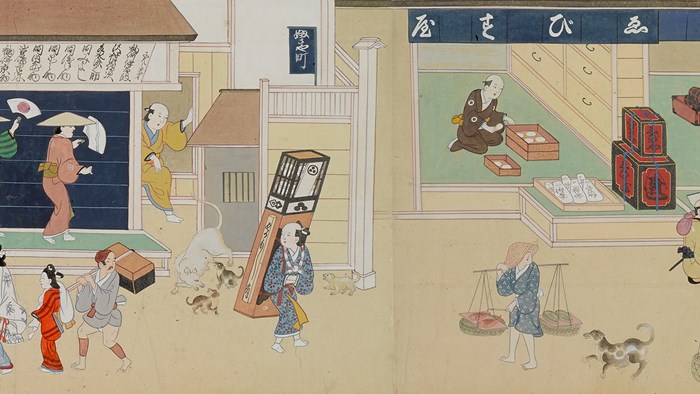
 Lady leaving palanquin
Lady leaving palanquinA high-ranking lady, wearing an expensive robe embroidered with gold, has just stepped out of her palanquin.
She is about to ascend the stairs to sit in one of the private boxes running around the sides of the theatre, rather than in the cheap seats in front of the stage.
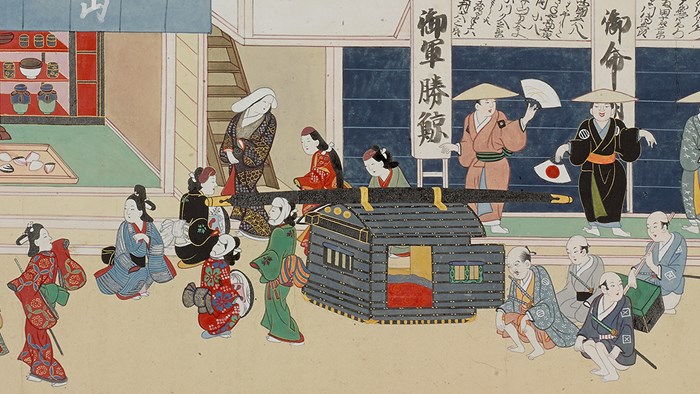
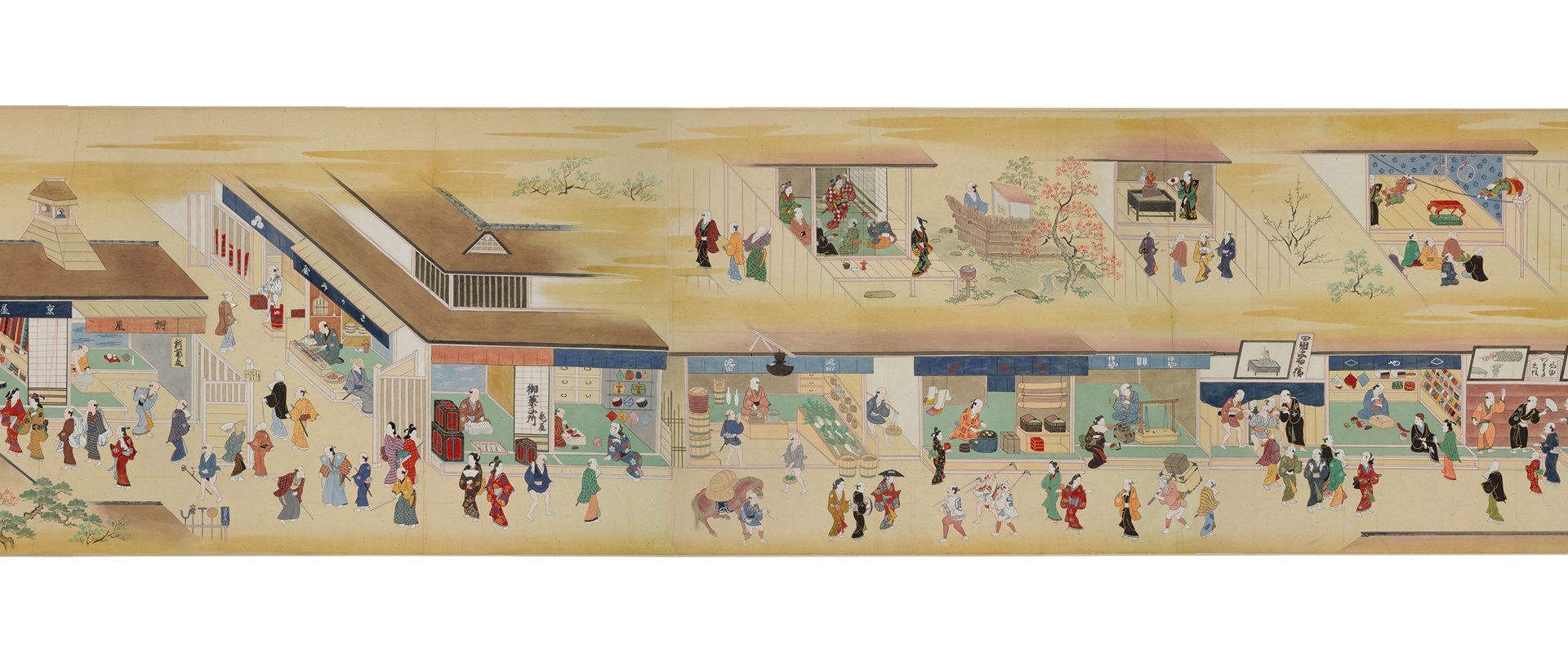
 Child acrobats
Child acrobatsTwo children leap and swing from a high wire above the heads of the audience as part of a display of karuwaza, or acrobatics.
Although passers by cannot see in, posters at the entrance show scenes of acrobats very similar to the action on stage.
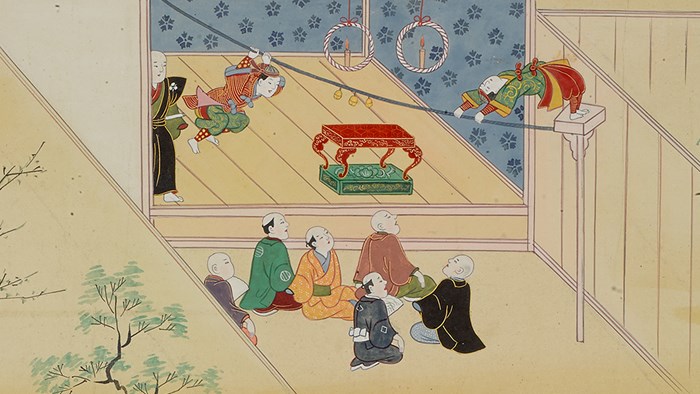
 End of the street
End of the streetThrough the neighbourhood gate, on a small side street, a customer sits at a stall selling kushiyaki, a popular type of fast food grilled on bamboo skewers.
The shop worker fans the flames to cook the food evenly. Kushiyaki is typically meat but can also be seafood or vegetables.
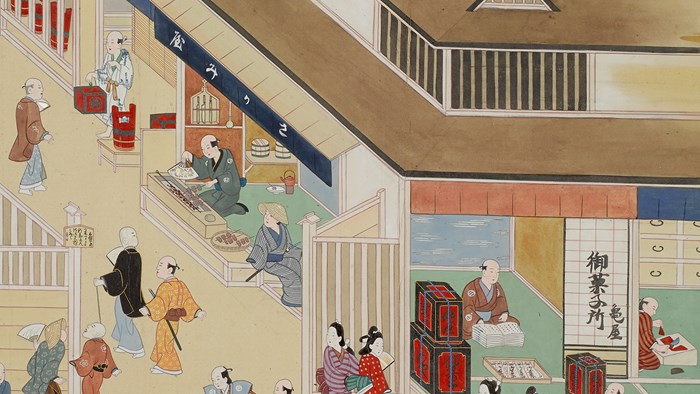
 Fire watchtower
Fire watchtowerAbove a shop stocked with rolls of textiles is a fire watchtower. Inside, a man waits vigilantly, ready to strike the drum at the first sign of fire.
Until the late 19th century most buildings in Japan were constructed from wood, and so fires were a frequent occurrence in any city and a real cause for concern.
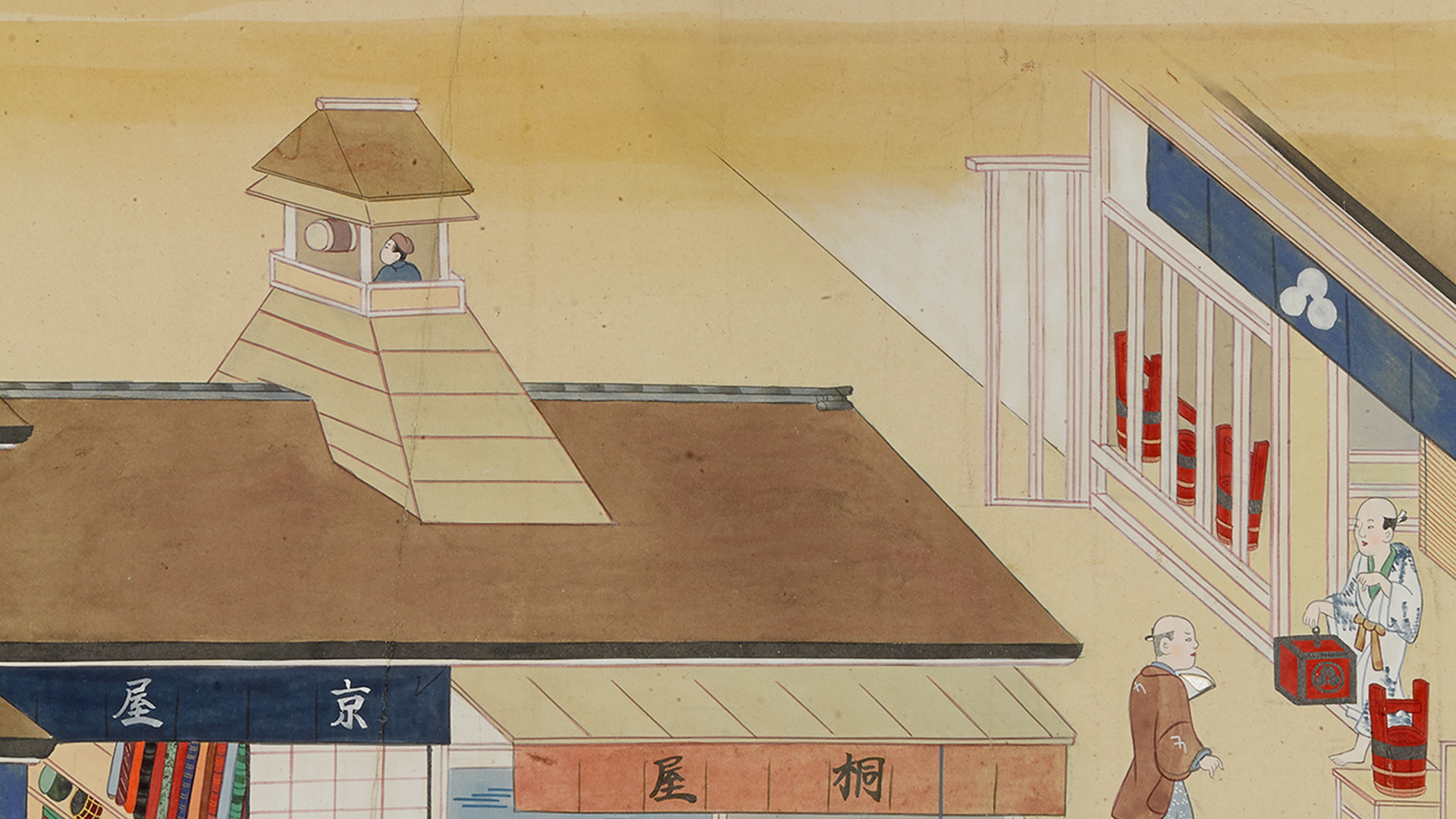
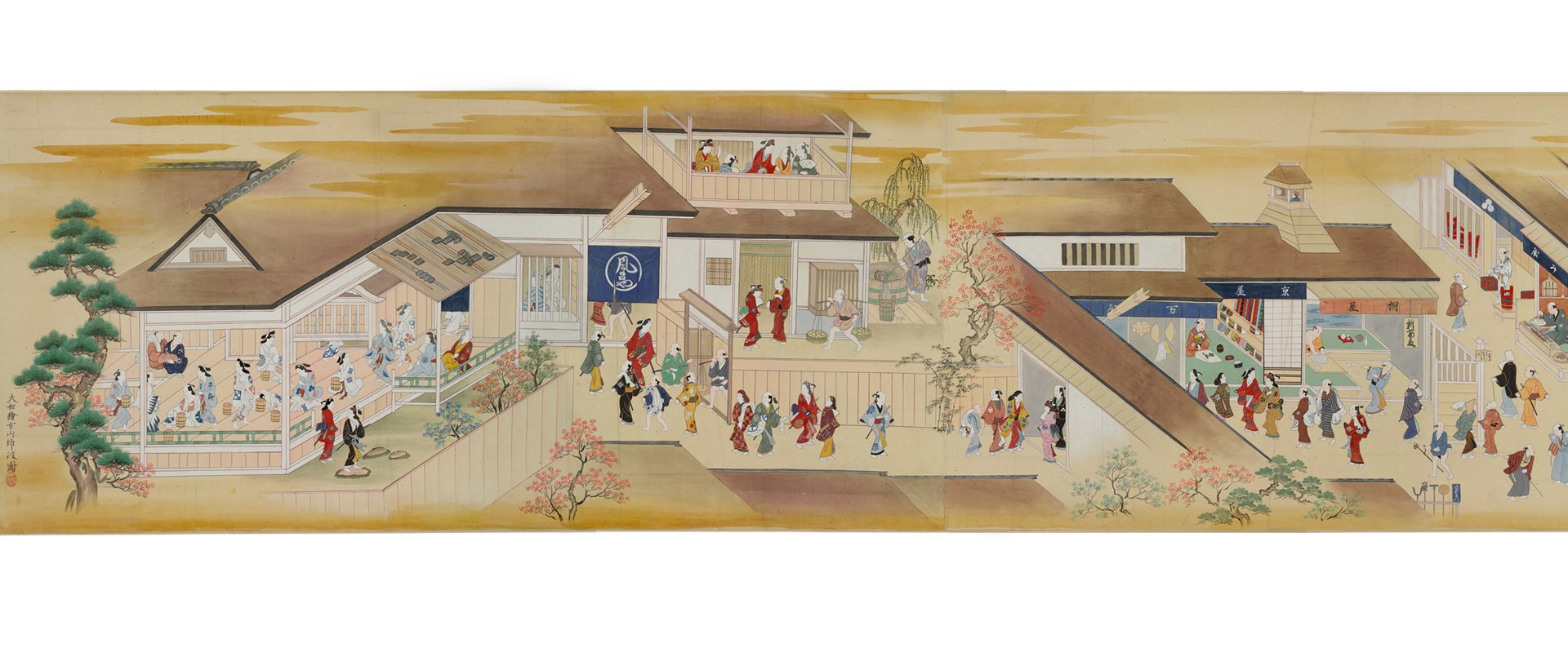
In Japan, scroll paintings are done on thin silk or paper, backed with layers of paper to give flexibility and strength as the work is repeatedly opened out and rolled up. These layers eventually wear out and need replacing. Watch this short video to find out more about the conservation.